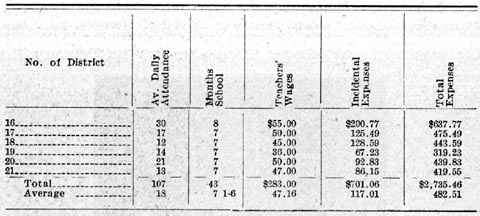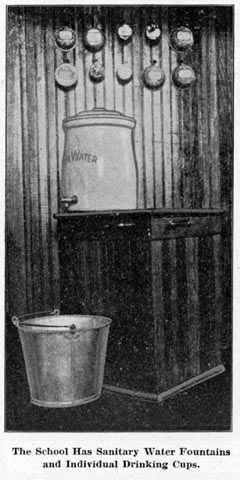NEGenWeb
Project
Resource Center
Schools
|
84
|
STATE SUPERINTENDENT'S REPORT
|
|
"try to teach everything;" that the children, even little girls,
should walk through mud and slush and in zero weather even as far as
two miles or go without education; that under the new system all high
school work would of necessity be abandoned. What then would be
thought of the present system if it came up as a new proposition for
the consideration of sensible men?
The arguments for such a change
could not he many. It might sound well to advocate the putting of
these horses and drivers to useful work, letting the children walk,
but to build eight houses instead of one, and to hire eight teachers
instead of three or four, all that a half dozen drivers and teams may
earn something in other ways would not seem economy. The schools
would certainly suffer as would the health of the little children.
Let him who has a lively imagination tell us what the mothers would
say whose children had always been transported warm and dry, when it
should be seriously proposed that hereafter the little ones should
wade while horses and mules spoiling for exercise stand in the barns
and kick the boards off for sheer amusement or lack of exercise.
CONCLUSIONS
Whatever differences of opinion may
exist among men who have studied this question, all must agree upon
the following points:
1. That many country school
districts are so small and weak that no school is conducted.
2. That many others consist of but
three or four pupils and the expense for elementary schooling
frequently rises to more then $100.00 per pupil, which is higher than
the tuition for collegiate instruction.
3. That at least one-third of the
country schools are too small to be even fairly successful.
4. That when the school is of fair
size, consisting of many classes of few each, with but one teacher to
de the work, the time is frittered away in a large number of short
recitations, often but five minutes each.
5. That fully one-third of all the
teachers have had less than one year's experience.
6. That the best teachers are taken
for the graded schools, and that of those available for country
schools, from fifty to seventy-five per cent. are "young girls" who
have had but little more training than Is given in the school they
are to attempt to teach.
7. That when schools are established
within walking distances of each other, the above mentioned
conditions are certain to fellow.
8. That as conditions exist today
little children walk long distances and suffer much discomfort and
ill-health by reason of exposure to storms and from sitting all day
with wet feet and damp clothing after wading snow drifts, slush, and
mud on the way to school. This is especially true of young girls.
9. That the only way ever tried or
even proposed by which these schools can be made effective is to
combine them into smaller numbers
|
|
CONSOLIDATION OF RURAL SCHOOL
|
85
|
with fewer and better teachers whose work can then be better
divided and better supervised.
10. That the only humane way of
putting children et all ages and conditions into school through all
kinds of weather is to transport them in wagons that are covered and,
when necessary, warmed.
11. That consolidation and
transportation tend greatly to lessen expense so that the same grade
of schools can be had much cheaper, or a far better grade at the same
expense, as patrons may desire, or, if they please, a full equivalent
of the best city schools may be established and conducted at slightly
greater cost than heretofore and at a much lower rate than in the
city.
12. That as things are today without
consolidation, country people not only pay more for elementary
instruction alone than city schools cost including the high school
course, but, in addition, farmers pay out vast sums for tuition and
other expenses of their older children attending city schools for
what is not offered at home.
13. That this condition often
results in the whole family "moving to town to educate the children,"
to the damage of the school left behind, to the disadvantage of the
business, at the expense of breaking up the old home and at the risk
of giving the family false ideas of both city and country life.
14. That the only proper way to
educate a child up to and including the high school is to do it
without disturbing his home or taking him out of it, and that the
country child Is entitled to as good an education as the city child
and at no more risk or inconvenience to him or his family.
15. That it is not necessary to
consolidate about a village school, but that wherever it is done the
result should he a country and not a city school.
16. That consolidation is the only
way of securing really good country schools, and it is the only means
of introducing the study of agriculture generally into the public
schools.
17. No one can avoid the conclusion
that the objections offered in advance of trial are mostly either
fanciful or selfish; that they are not realized in practice; that
consolidation is the only plan tried or proposed by which the country
child can secure such an education as modern conditions demand, and
such as Is already afforded the city child.
18. It cheapens the expense and
equalizes the cost; It protects the health and morals of the child
and makes the introduction of agriculture and the other industries
possible; it enhances the value of farm property as a whole; it
brightens and broadens country life; It preserves its virility
unimpaired and rationalizes the movement toward population centers.
Such difficulties as are found are trivial or transient, or both, and
are such as would not stand in the way of any commercial enterprise
for a moment.
19. Consolidation of country schools
is the solution of the prob-
|
86
|
STATE SUPERINTENDENT'S REPORT
|
|
lem of agricultural education and it is the only complete solution
that has been offered.
COST
Certainly no plan to change, in any
manner, our present system of rural schools can make any headway
unless the item of cost is thoroughly considered and understood.
However, in any discussion of consolidation, and the expenses
incident thereto, it should be remembered that our present system is
probably the most extravagant and wasteful, from a money standpoint,
that could be devised. It has already been shown that the average
rural school costs the taxpayer per capita anywhere from one hundred
to several hundred per cent. more than the most elaborate system of
city schools.
When we reflect further that
one-half of the present number of teachers would be sufficient to
teach all of the pupils of the state could they be conveniently
grouped, we will readily see that the ultimate outcome of
consolidation means a great saving to the people.
In almost every plan of
consolidation, the cost after consolidation for the same number of
months at the same wages for teachers is considerably less. For the
same cost, the term usually can be materially lengthened and the
wages of the teachers increased.
That our small schools are costing
the people an amount entirely out of proportion to the results
obtained or the advantages offered has already been shown in a
striking manner by the tables found on pages 8 and 9.
In support of the statement that the
consolidated school is less expensive per capita, the attention of
the reader Is called to the following additional facts:
1. Under consolidation there Is no
duplication of libraries, of apparatus, and of other equipment
necessary.
2. A considerable saving in fuel and
beating equipment is effected.
3. Less outlay is required for
maintenance, repairs and janitor service.
4. Less capital is Invested In
buildings.
5. In practically every case the
number of teachers needed is largely reduced, thus making a definite
saving.
6. Ordinarily enough can be saved
through the various means suggested to meet the extra cost of
transportation. As a reward for this we have a more efficient school,
better teachers, a longer term, the possibility of some high-school
work and the inspiration of numbers.
The following estimate of certain
school districts may serve as a valuable illustration:
|
|
CONSOLIDATION OF RURAL SCHOOL
|
87
|
ESTIMATING THE COST OF CONSOLIDATION.
Below is an illustration of an
average financial exhibit of a proposition to consolidate in a county
densely populated:
ORIGINAL DATA FROM RECORDS.

SUMMARY OF EXPENSES BEFORE CONSOLIDATION.
|
Teachers' wages, fuel and repairs for 6 schools
|
$2,735.06
|
|
|
Interest at 5 per rent on $6,000 (estimated) investment
in 6 schoolhouses
|
300.00
|
|
|
Depreciation (estimated) per year on 6 school buildings
---------------
|
240.00
|
|
|
|
--------
|
|
|
|
|
$3,275.06
|
EXHIBIT OF EXPENSES AFTER CONSOLIDATION.
|
3 teachers for 7 1-5 months, at $47.16 per month
|
1,013.94
|
|
|
5 wagons for 7 1-0 months, at 70 per month
|
1075.00
|
|
|
Fuel, repairs, etc., for three schools
|
351.03
|
|
|
Interest at 5 per rant on $3,000 invested in 1 school
rooms
|
120.00
|
|
|
Depreciation per year on three schoolrooms
|
120.00
|
|
|
|
---------
|
|
Total
|
|
$2,709.97
|
Net saving
|
|
$ 565.09
|
By increasing the number of wagons
to six, increasing the teachers' wages to $55 per month and
increasing the length of term to eight months, the net saving is
still $37.01.
Minor items almost negligible are
omitted in the mode of estimating illustrated above.
The demand of the day Is not for
cheaper schools, however, but for better schools for the money
invested. The question is not so much one of cost as it is one of
returns for the money invested. The present, rural school system pays
very dearly for what it offers in return.
|
88
|
STATE SUPERINTENDENT'S REPORT
|
|
THE SHOLES CONSOLIDATED
SCHOOL.
The Sholes Consolidated School is
one of which the village of Sholes and the community are proud; It is
one of which the county of Wayne is proud; and it is one of which all
Nebraska should be proud.
But where is Sholes? I venture to
say that every one of the readers of this article knows something
about the consolidated schools of Winnebago county, Illinois. But why
not direct attention for a moment to one of our own consolidated
schools located in Wayne county
The School Has Sanitary Water
Fountains and Individual Drinking Cups.


|

|

|

|
© 2003 for the NEGenWeb Project by Ted & Carole
Miller
|





